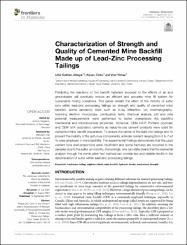Characterization of strength and quality of cemented mine backfill made up of lead-zinc processing tailings
Citation
Akkay, U.G., Cinku, K. & Yilmaz, E. (2021). Characterization of Strength and Quality of Cemented Mine Backfill Made up of Lead-Zinc Processing Tailings. Frontiers in Materials, 8, 740116. https://doi.org/10.3389/fmats.2021.740116Abstract
Predicting the reactions of the backfill materials exposed to the effects of air and groundwater will eventually ensure an efficient and accurate mine fill system for sustainable mining operations. This paper reveals the effect of the mobility of sulfur ions within lead-zinc processing tailings on strength and quality of cemented mine backfills. Some laboratory tests such as X-ray diffraction, ion chromatography, scanning electron microscopy, combustion tests, chemical analysis, pH and zeta potential measurements were performed to better characterize the backfill's mechanical and microstructural properties. Moreover, CEM II/A-P Portland pozzolan and CEM IV/A pozzolanic cements as ready-to-use cement products were used for cemented mine backfill preparation. To ensure the carrier of the lead-zinc tailings and to prevent the mobility of the sulfurous components, a binder content ranging from 3 to 7 wt% were employed in mine backfills. The experimental findings demonstrate that the used cement type and proportions were insufficient and some fractures are occurred in the samples due to the sulfur ion mobility. Accordingly, one can state clearly that the elemental analysis through the combustion test method can provide fast and reliable results in the determination of sulfur within lead-zinc processing tailings.


















